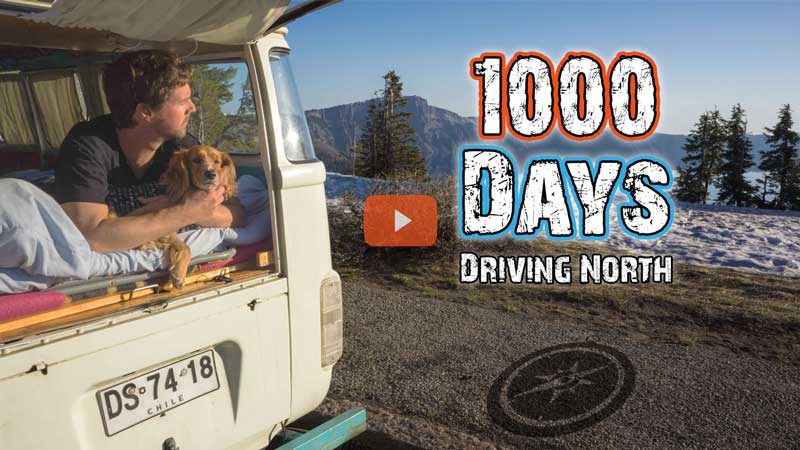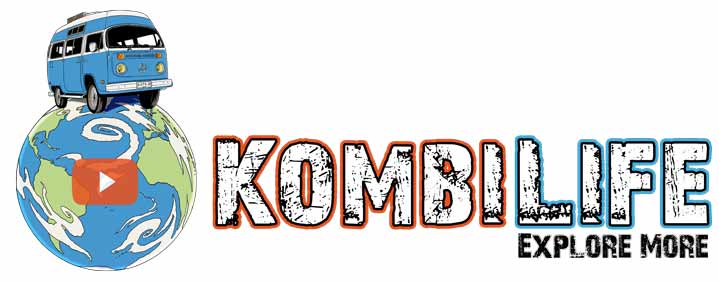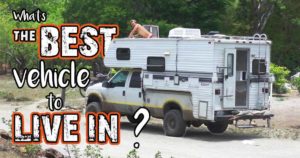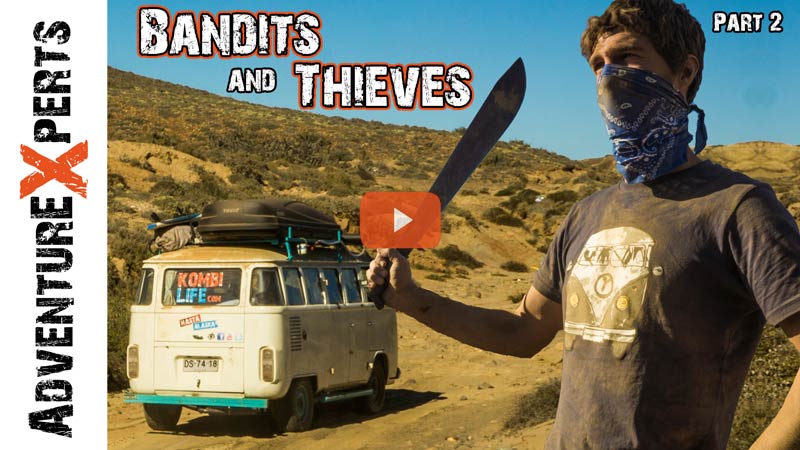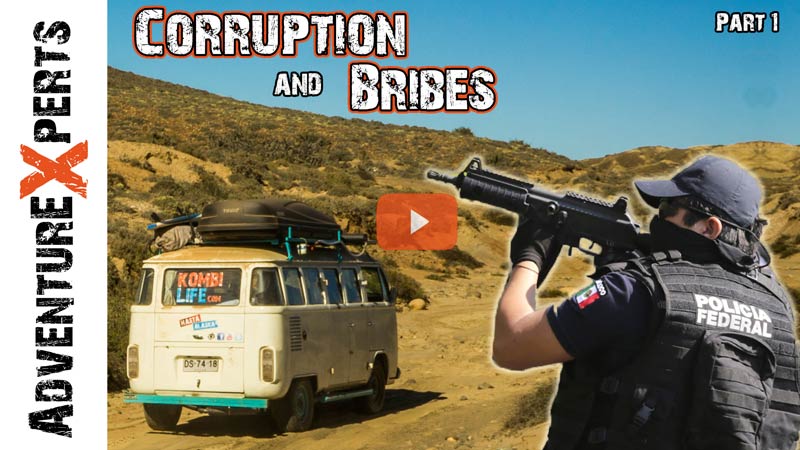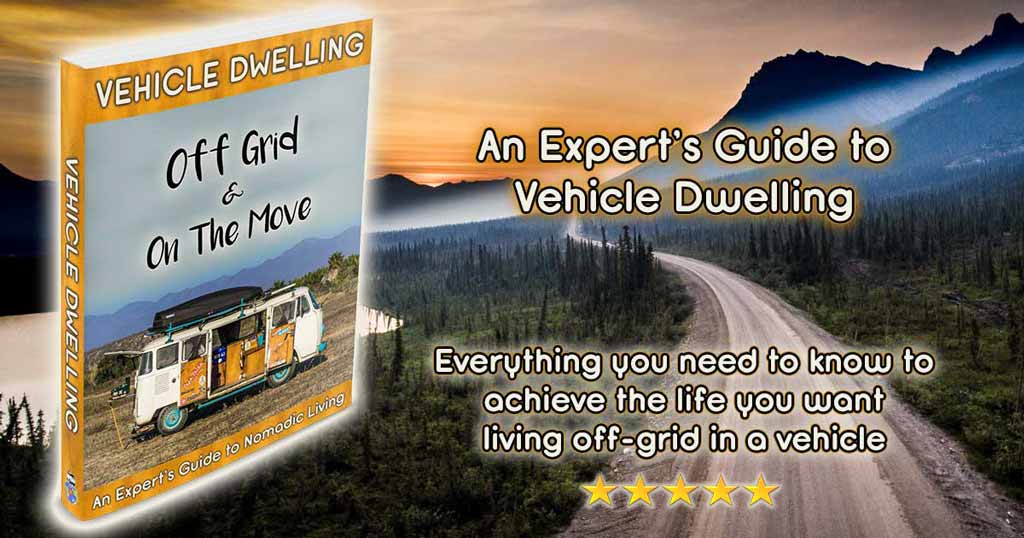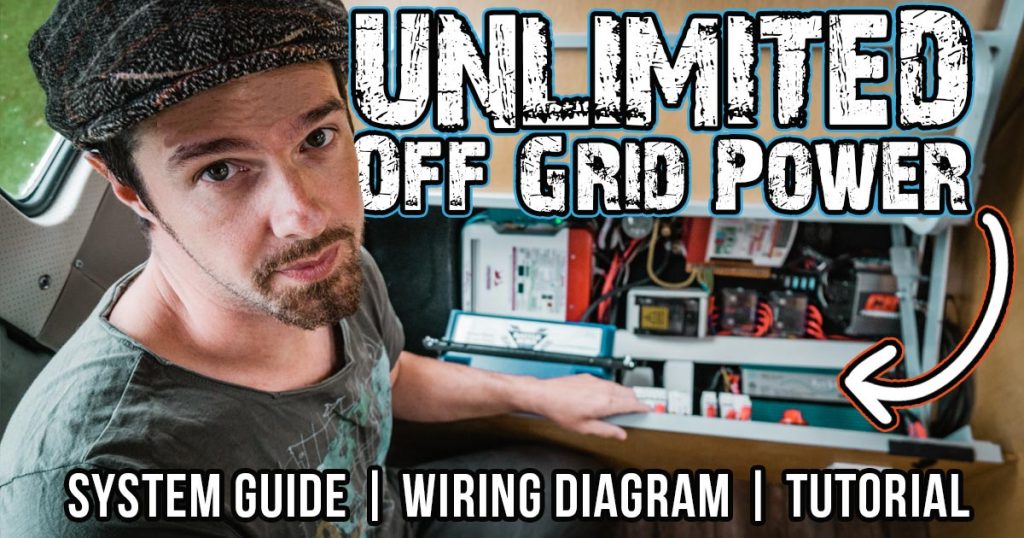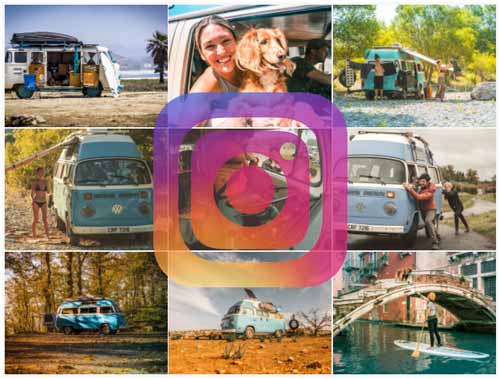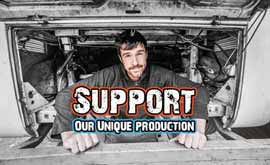Top 10 Van Life and Overland Questions (FAQs)
Top Kombi Life FAQ’s
How can you afford to live like this?
What camera do you shoot with / How do you make the videos?
What will you do after Alaska?
Why have you had so many problems with your Bus?
Why are you filming and not blogging?
Why are your early videos unavailable on YouTube / How can I watch them?
Top Van Life FAQ’S
How much do you spend on average?
Where do you wash/go to the toilet
How do you deal with condensation?
How did you train Alaska (the van dog) so well?
How do you get/make electricity?
What Gear and Tech do you recommend for Van Life / Overlanding?
Top Overlanding FAQ’s
How do you decide where to go?
What about corruption/police/borders?
What advice would you give to someone wanting to do their own trip?
What is it like traveling with a dog?
Why do you do the repairs yourself when you are not a mechanic?
What advice do you have for crossing the Darien Gap?
*Products linked on this page go to Amazon.com
Click to find more advice and information about Van Life
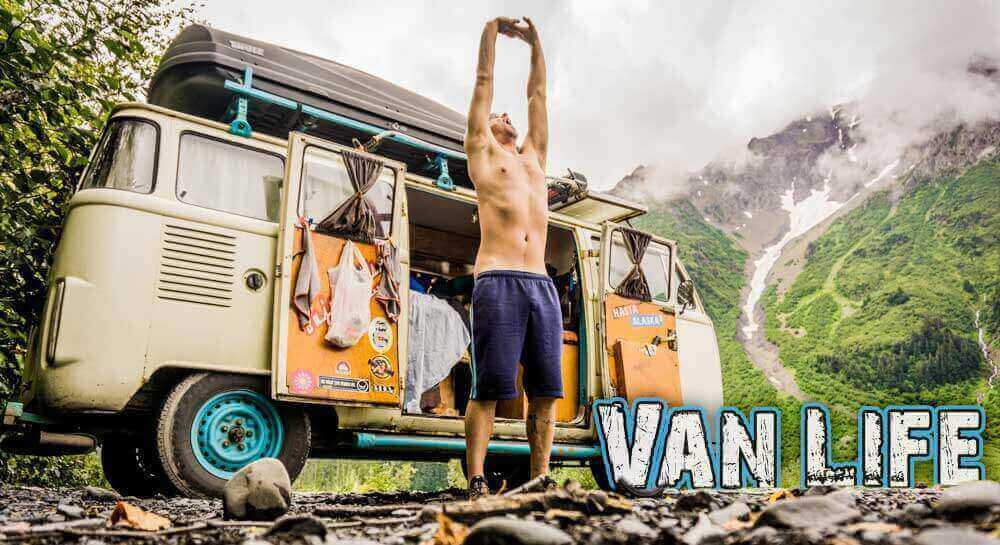
What does Hasta Alaska mean?
“Hasta Alaska” was the name of our crazy Pan-American Overlanding Project, Hasta is Spanish for “until” – so it means “Until Alaska” In Spanish, the ‘H’ is silent so it is pronounced “Asta Alaska.”
What is Kombi Life
Read about Kombi Life on our About Page.
How can you afford to live like this?
We saved all the money for the trip before we set off, mainly by working every hour and every day possible – a small sacrifice we think. It’s not as simple as that however.
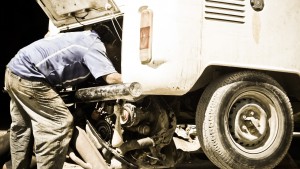
We now make a little gas money on the road from you guys! When you buy online through Amazon via our links we get a small percentage referral and it costs you nothing, which we are big fans of. Also, we can travel for so long because we keep our costs to an absolute minimum! We eat out once a day, usually where the locals eat. We cook ourselves for the other 1 or 2 meals in the day. Meat and cheese are a luxury of the past. Most of our meals, though delicious, are concocted from the most economically locally sourced ingredients. We will occasionally stay in budget backpacker hostels, but usually only once or twice a year and only when we have no other choice.
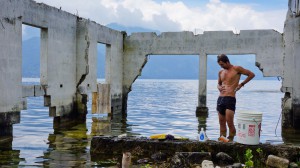
We almost never stay in campsites or pay to park. We shower where the locals do in lakes, rivers, waterfalls, and if all else fails, in the ocean, and when we do we use environmentally friendly organic soaps.
Living in a van is one of the most affordable ways to travel. It’s much more achievable than you think, especially when you share your vehicle and the travel costs with other backpacks that you meet on the road like we did with our Hasta Alaska Project.
How Much Money Do You Make?
Are you thinking about sharing your own passion on YouTUBE? We hope so because our generation needs as much inspiration as possible if we are going to put our happiness before conformity. Check out our article on this subject for a detailed answer. We also made a video for our Patreon members showing exactly how much money we make on YouTube from 1 year of vlogging.
Why do you live like this?
We know that this lifestyle isn’t for everyone, in fact, there are a few downsides to Van Life; but any sacrifices we have to make by living in a Kombi pale into insignificance by the rewards it offers. It enables us to travel cheaper than regular backpackers; usually, we spend less per day than a single traveler does just on a dorm room in a budget hostel.
*This does not include repairs, which now sadly accounts for the large majority of our expenses.
It allows us to wake up in the most stunning places for free, whereas we would not be able to afford hotels with a similar view.

A sad truth is that the local people are usually less friendly in the most touristic locations. We do hit many of the tourist ‘hot-spots on our travels but we often gain the most rewarding encounters with other cultures when we stop in towns and villages off the beaten track. If we were traveling by public transport we would have missed out on many of our favorite moments.
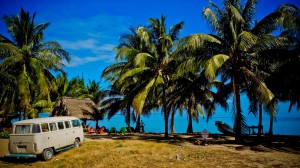
Having the ability to stop when we want, go where we want, and leave when we want gives us a freedom that most people never experience in a lifetime!
How much do you spend on average?
This is a really popular question which either means you are just curious or that you are planning a trip yourself, we really hope that it’s the latter of the two.
Obviously, spending varies depending on the country you are in. North America, with the exception of Mexico (as you might expect), is less bang for your buck. The cheapest countries in Central America are Nicaragua and Guatemala, the most expensive are Belize and Costa Rica, with El Salvador somewhere in the middle. A lot of South America is cheap enough, with Brazil, Argentina, and Chile being the most expensive for us.
We aim for an average spend of $125 US each per week if we are ‘traveling’. That includes gas, food, and entertainment. When we are more people we spend less on food but more on Rum/Tequila, when we travel further we spend more. As money is getting tighter we often spend less than $100 p/w for 2 people and a dog, but we are well skilled at hunting out the best local deals! We guess you could say that we have a $10 per day rule, that is our rough guide but we don’t stress it.
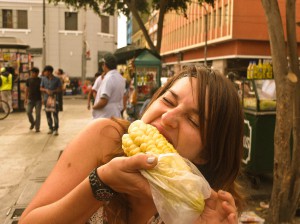
We rarely pay for tours, trying to make our own source of entertainment. If you want to be hurling yourself down every zip line you come across and be guided around every national park that you pass, you can easily spend 3 to 4 times what we spend.
A few average costs (all in USD)
- A Kombi before love $1000 – $7500
- A kombi after love, over $10,000
- A tank of gas $40-$60 (~375kms)(~250 miles)
- 5 gallons of drinking water $0.75c – $2.50
- Budget restaurant meal – $3 – $8
- A shower $1 – $2
- Budget accommodation $4 – $25 (night in a dorm)
- Small beer $1 – $3.50
- Soda $60c
- Loaf of bread $2
- Liter of milk $1 – $2
- Ice cream double scoop, waffle cone, chocolate-dipped 😉 $1.50 (and worth every cent)
(These prices are averaged and are from the Latin America part of our trip, not including Cuba which was ridiculously cheap)
What camera do you shoot with / How do you make the videos?
We’re always updating our equipment to move with the times. So check out this page to see what is in our camera bag right now (plus other lifestyle gear we use)
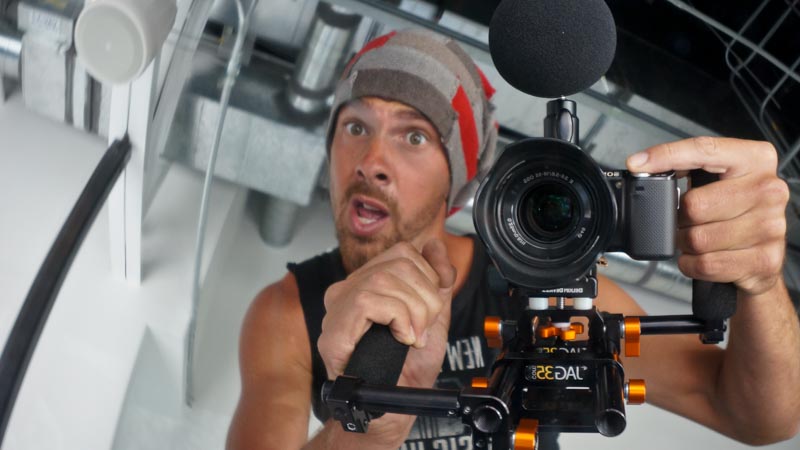
What will you do after Alaska?
We’re now driving around the world – Watch the series here
Where/what do we eat?
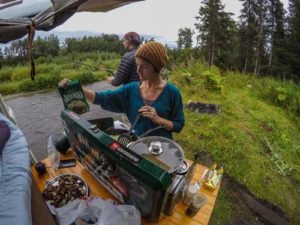
We generally eat eggs for breakfast, although I don’t really appreciate them so I try and get my greasy little mitts on a box of cereal when I can.

If we are not eating street food we are cooking, however, street food can almost be as cheap as cooking (not true if you are more than 2 people.)
If you don’t have a fridge in your campervan meal times can get quite creative and having fresh vegetables and dairy products can be a challenge. But you can make it work as we have done.
I can count on one hand how many times we’ve eaten “out-out” in the past year – the most expensive being $20 for 2 people, it was ribs and we can still taste them now 🙂
Fine dining is available if you are vacationing in these locations, however, we can’t tell you much about that – but then you already knew that, and that’s why you are following us. 😉
Where do we wash/go to the toilet
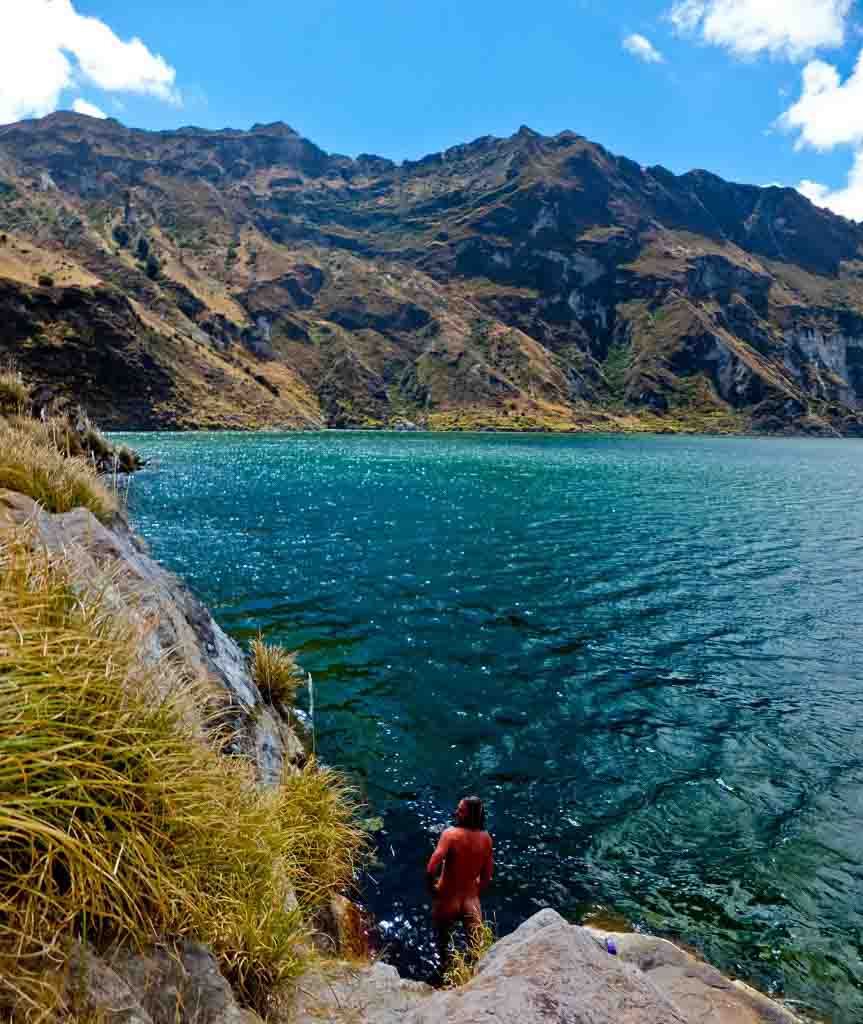
We keep clean on the road by freshening up in rivers, waterfalls, lakes, and wherever we see a local washing hole. If there is a tap at a garage we will use it and a lock on a public toilet = shower time.
On our first Van, we had a Solar Shower installed on our roof which heats up during the day and allows us to pressurize the 6GL tank which is great for bathing and washing, and de-salting after a surf. Of course, there are plenty of other shower options that will suit your rig and needs.
When we build Boomerang to drive around the world we wanted a dedicated hot water system so we could still shower in cold climates. We show you how you can do that in our free guide to van life water systems

Toilets (or lack thereof) are the biggest pain. Most people will take 25-75c off you for the privilege of negotiating the release of some chocolate hostages and this can add up quickly when you are pinching the pennies.
Of course, if we are outside of civilization we have the most beautiful toilets in the world 😉
We wrote a dedicated article comparing the toilet options available for van life
Where do you sleep?
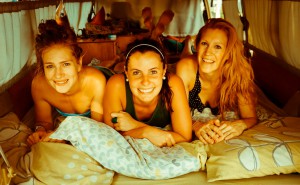
Well, when our Kombi isn’t deciding that, we always prefer somewhere with a million-dollar view – and most of the time we get it! We try to avoid spending too much time in the bigger cities, they just aren’t campervan friendly.
Paying for parking isn’t something we ever opt for, which means sometimes we have to stealth camp or look for other free camping spots. In most countries throughout Latin America pulling up outside 24-hour businesses like garages, stores or pharmacies is always one of the more secure (free) choices. Also, the police will happily let you park up at the station if you are really worried about the locals.
Most people advise against parking in isolated spots due to crime, but they often give us the most beautiful and memorable mornings and we love waking up to a champagne view on a lemonade budget!
Check here for more Van Life Tips and Advice

Why a VW Bus?
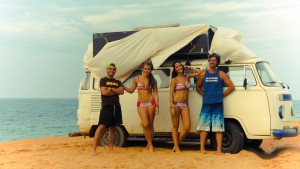
We ask ourselves that every day! The main reason I bought a VW Bus was not because of nostalgic memories of touring Europe with my family in a German Kombi during my youth, but rather because it was the cheapest ‘van’ available in Chile when I set out!
We can’t deny that if we had opted for the Japanese ambulance (option #2 after Co’Pito) that we would probably have arrived in Alaska in half the time and with half of the problems. That said – for better or for worse – we now love our little home. Maybe it is because we don’t know another vehicle on the planet that is capable of bringing as many smiles to the faces of strangers or maybe it’s because if it was any other ‘van’ we wouldn’t have half as many internet passengers.
Either way, we made a commitment to Co’Pito when we left that we would all arrive in Alaska – together – so that is what is going to happen…somehow!
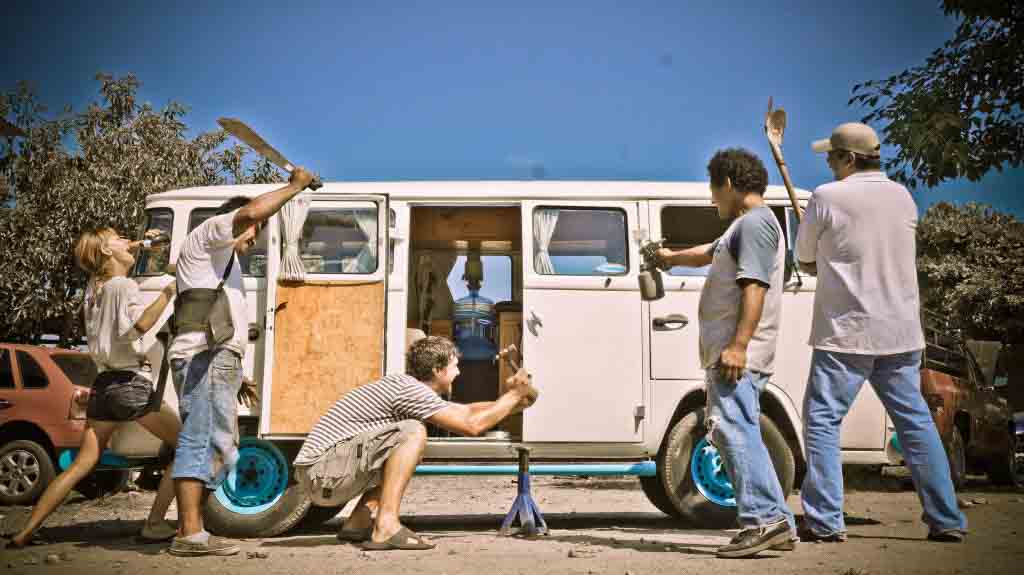
Check out this article where we weigh up the pros and cons of the various vehicles that are adopted for living…(including the kombi)
Have you been robbed?
Obviously, we are a target and security is always our top priority every time we leave our vulnerable home. So far we’ve never had the windows smashed (by other people) or locks busted open. That’s the good news! However, the reality is, we’ve had people try our door handles and stick their hands in the windows at night; we’ve had the jerry can stolen from the roof; a camera swiped from the front seat; various items of clothing snatched when we weren’t looking and a surfboard smuggled out of the shadows, just 15ft from Co’Pito. Probably the worst incident was having a bag stolen in Bolivia which contained money a new camera and a passport.
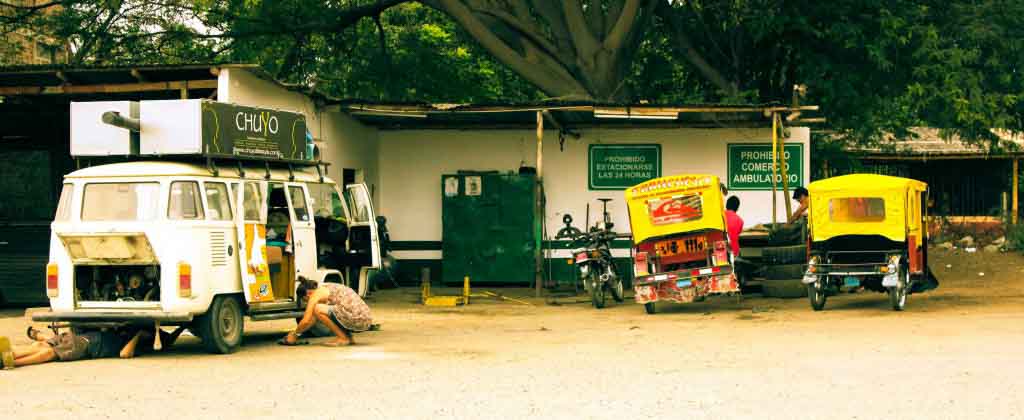
Common sense is your best friend here. Keep everything out of sight when you are away from home, keep everything in sight when you are at home. Keep your eyes on the prize and don’t step away without locking up. We have a Fire Resistant Steel Security Box for money and passports, secret stash places for larger valuables, and a homemade engine cut-off switch for the absolute worst-case scenario.
Hear more about how we dealt with Bandits and Thieves in this episode of our Adventure Experts Series.
Have you had any accidents?
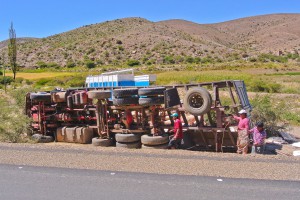
Latino highways seem to dance to their own beat so understandably we’ve had a few close shaves.
An El Salvadorian van overtook us without enough room, cut in too close at 50mph, and ripped off their bumper in the process (no damage to us). A bus pulled out and scratching the whole side of Co’Pito in Lima, Peru. In the city, any accident involving a foreign driver is automatically the foreigner’s fault so we had no choice but to leave the scene. In the central Guatemalan mountains, the motorbikes have bullhorns on their handlebars. A careless motorcyclist who was looking at the ground rode into the front of our Bus denting Co’Pitos face; he didn’t stick around long enough to talk to us for me to catch him.
The worst part is that we had just spent 5 months restoring the Bus in Mexico, had only been out of the mechanics for 6 days, and hadn’t even taken a picture of the Bus all finished before it happened! And believe it or not, this happened again when we built Boomerang. 1 Year building and we crashed it in the first 10 miles. Check out the Season 3 finale
That said we are very grateful that thus far there have been no major incidents!
How did you train Alaska so well?

You might be surprised to hear that Alaska is a bit of a rarity in Latin America, not just because she lives in a Kombi, but because she is free like a street dog whilst still doing almost anything we tell her to. How? It all starts with food.
When we gave Alaska food we tell her to SIT, eventually, she will sit (probably out of boredom), then she gets her food. Soon enough she knows what SIT means, the same goes for WAIT, LIE DOWN, or whatever else you want your pup to do.
The most important thing is, by controlling the food, she now knows that we are the boss….the rest is easy! We trained Alaska in Spanish because she is from Peru and YES, it does feel stupid speaking Spanish to her in English-speaking countries.
There are lots of great sites out there on how to train your dog (Google is your friend), just remember you will get a lot further with your K9 by training with love rather than punishments!
How do you deal with condensation?
This is a tough one that still has us stumped. There is no 100% fix for condensation. You can reduce the problem with good ventilation, circulation of air, and insulation. We keep the windows cracked for ventilation, don’t cook inside when it’s a chilly night, and just deal with the unavoidable drips in the morning. When the sun comes up, we air everything out and wipe down all of the surfaces to remove as much moisture as possible. If you have any suggestions, please feel free to comment at the bottom of this page.
Since discussing this problem on our YouTube channel, a number of viewers have recommended this product below. We’re intending to get one just as soon as we are in a place long enough to receive a delivery.
How do you decide where to go?
Usually through word of mouth or speaking to locals and other tourists. We’ve had this type of Guide Book previously, or picked up a free tourist map at the border (not always available). In the absence of a map we just use a compass or the sun. Signposts are often either non-existent or unreliable in the Latino world. When we are hunting for a surf we use Wannasurf for the free surf spot guides, GoogleMaps to find secret spots and Magic Seaweed for the swell report.
We also use a variety of smartphone apps to helps us find cool stuff to see and epic places to wake up. We made a video about the Best Smartphone Apps for Van Life and Overlanding, check it out.
How did you learn Spanish?
On a trip like this, you WILL need some Spanish skills! I didn’t speak a word of it when I arrived in South America and I wasn’t really learning much in the hostel tourist scene as there was always someone who spoke more Spanish than me.

I decided to help a Chilean family out in a help exchange program, helping them build houses, in return, I got to live, eat and sleep with the non-English speaking family. I can’t recommend the experience more highly – it’s not easy, but you sure do learn quickly.
A Spanish dictionary like this, and Lonely Planet Latin American Spanish Phrasebook is a big help, these two are popular. I also spent over 9 months living in Mechanics in various places – that helped a bit too, especially for some of the more ‘colorful phrases’ 😉
In the early days, I found a few of the free smartphone apps for learning Spanish useful. If you want to study Spanish, Guatemala (San Pedro La Laguna) is a great place – roughly $70US for 4hrs per day, 5-day course, one-on-one tuition. They speak very easy-to-understand Spanish in Guatemala, Colombia, Ecuador, and Peru.
Is it hot/cold in the van?
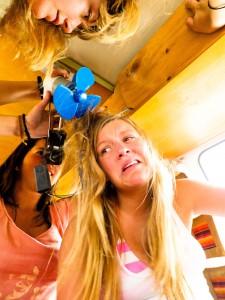
Check out our Van Life Page for recommendations on Gear to make Van Life more comfortable.
Our first Bus didn’t have any heating, so when we crossed the Andes we pulled over and put on every item of clothing we had. At night time we have enough blankets to keep us warm and on the nights when the ice forms on the inside of the windows, we just make a spoon-train. 🙂 Those are our favorite nights!
We were very kindly given one of these Mr. Heater for the journey north by Doug in Canmore, just as well because it’s cold up there! There are plenty of other heating options for your rig so you don’t need to freeze.
We don’t have a pop-top roof or any really good ventilation in the bed area so we thought that the tropics would be unbearable, but it hasn’t been all that bad. Sometimes we will keep the back door ajar a little on the worst days and we do have a mini 12v fan hooked up to our aux battery but this is only for a short burst of glorious refreshment. We also have a USB-powered fan which is much more economical to use and works great if placed close to you.
The best trick is the simplest…we get out the compass, look east and make sure that we’ll be parked in the shade in the morning. We usually get up with the sun when the day is cool and at it’s most beautiful.
What about corruption/police/borders/bandits?
Surprisingly the Police have been much better than we were expecting but there are times when we know we are being set up to pay some fictitious fine. We’ve tried a whole bunch of tactics but the easiest and quickest way is…”mi no hablo Espaňol bueno.” Just make sure you don’t speak a word of it and they soon tire and send you on your way.
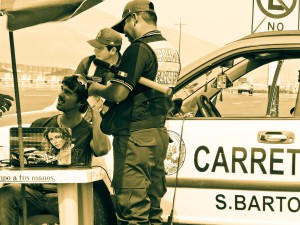
Also it’s inadvisable to hand over any documents that can be held as ransom, better to give them copies. Be polite and patient, more often than not they are just bored and curious.
It’s worth noting that the Mexican police are known to take your license plates, it’s a good idea to replace the screws with rivets. We have other tips on traveling in Mexico you should read but in all honesty, you’ll find that it’s safer to travel than you think.
As for borders, they can take between 1 and 3 hours on average. They are quietest early in the morning. Don’t pay anything without proof of the “tax/charge/fee” always get a receipt! They WILL try and get money out of you occasionally. It’s not a good idea to overstay your visa, it is a TERRIBLE idea to overstay your car’s temporary import permit.
Contrary to popular belief the money change touts on both sides of the border are often the best (and sometimes the only) place to change local currencies. You should be able to change major currencies at some banks.
There are often guides at the borders who will hold your hand for a small ‘tip’. Take it from us that you don’t need help. Watch my crossing borders with pets video to get an idea of the steps involved and it is more or less the same process at each border.
As for bandits. No matter where you are in the world people are always afraid of the “unknown” and “over there.” People throughout the trip have always warned us about the next country or town as being dangerous.
We’ve hitch-hiked through the murder capital of the world and mountain biked the most dangerous road in the world and they have been some of our best memories. It can be dangerous out there and it pays to keep an ear to the ground for political unrest, but as long as you are sensible and try to avoid driving at night (more for road conditions than bandits) you shouldn’t take a locals word for granted about the ‘dangers’ in the next land!
That said, use your wit and don’t stick around if people look like they are reaching for their pistol 😉
Hear about how we dealt with Borders, Corruption, and Bribes in this episode of our Adventure Experts Series
What advice would you give to someone wanting to do their own trip?
It’s exciting to hear from so many of you who are planning your own trip of a lifetime! Let us tell you that you will NEVER regret it, that we can absolutely guarantee!
The best advice we could give you is to stop procrastinating and start doing! Planning really is overrated, it isn’t rocket science and you don’t need to know what is behind every rock before you set off. This is a controversial statement we know, but we strongly believe it isn’t an adventure until things start going wrong and that you will be throwing away any plan you previously made as soon as you surrender to the will of the wind.

If you would like specific information about living in a vehicle we have combined everything we know into this one eBook which will make the whole process easier for you. It is available for download
You will want to make sure that your vehicle is in good condition before you set off, change out any questionable parts, and make sure you have spares for anything that breaks often. Advice on how to do a trip like this isn’t in short supply so get googling guys.
What we will tell you is about is doing a trip like this in a VW Bus like ours… If you are thinking of using your Bus, you should know that parts for late model kombis are easy to find in Mexico and Guatemala. They get increasingly difficult to find until you get as far south as Peru, although in all capital cities you should be able to find the parts you need. Type 4 parts are hard to come by; early model parts are also tricky.
You would greatly benefit from a gauge for oil pressure, oil temp, and head temp, that way you can tell when you are asking too much of your vehicle.
If you are thinking about flying in and buying a Kombi when you get there, they are the cheapest in Mexico and Brazil. In Mexico, the large majority of VW Buses on road are water-cooled, probably better suited to the extremes of the Latino journey that you will undertake but supplies might be hard to find outside of when you are far from Mexico or Brazil.
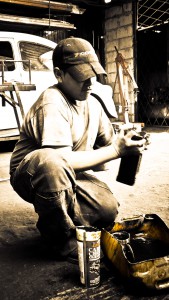
As a foreigner, you can’t take a car out of Argentina during the first year of owning it, which is why I went to Chile to buy Co’Pito. Double-check the regulations on your destination before you get there. Make sure you have ALL of the paperwork in order before you set off. Power of Attorney papers are OK, title of ownership documents are better.
You will need to learn some basic mechanics and you will definitely need a couple of good manuals. You don’t want to trust any old mechanic to do a good job and VW specialist mechanics aren’t available everywhere.
If your Bus starts behaving badly stop and fix it and always do your scheduled maintenance, especially the 3000-mile tune-up. Try to do this yourself so you know it is done properly.
And make sure you make friends with The Samba Boys, they love a good adventure are a cracking support crew, and would be happy to help you arrive in your destination.
What is it like traveling with a dog?
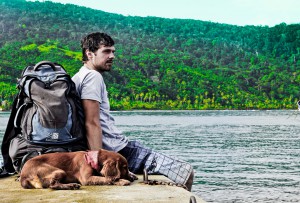
Errr, Brilliant! We love Alaska and it is now hard to imagine life without her. She is the perfect travel companion, sleeps when we are chilling, makes friends even quicker than we do, and gives us an excuse to walk around the towns rather than drive.
Alaska is without doubt one of the best things that has come out of this trip. There are places that don’t like dogs, fancy tourist beaches and the occasional restaurant (fair enough), some national parks, and most shopping centers. We could leave her outside but anything that doesn’t look like a street dog has value in the Latino world and unfortunately, people have tried to make off with her. If you are traveling with a dog and it is good-looking (by street-dog standards) then I wouldn’t recommend leaving it anywhere unaccompanied. We had people try to take Alaska from right by our side on several occasions.
As you can probably imagine there are street dogs everywhere, but what you may not realize is that they are often not the feral beasts that you are led to believe. Most have owners, many just want to make friends, and fights are rare. Males are the dominant sex so a female dog is the least hassle to travel with – unless she is on heat…and then good luck!
f your dog is aggressive/territorial then you will need to keep him by your side to stop him from being cornered by local dogs (in certain locations). None of the above would stop me from traveling with a dog, you just need to be aware that other dogs aren’t trained and if your dog isn’t very well trained then you will have a harder time. Any street dog will go running away the second you touch your ankle (they think you are throwing a rock). They become braver and more of a problem at night and especially at night when in packs (rare).
The documents that you require for crossing borders are subject to change so check the latest information for the countries that you are planning to visit. The minimum that you are supposed to have is a current rabies vaccination and a recent health certificate signed and stamped by a local vet. In practice, we just made sure our dog had all the vaccinations and relevant jabs for the area (why wouldn’t you?) and just crossed without drawing any attention to her. The worst that could happen is they send you back to the nearest town in search of a vet. In the end, we saved ourselves a lot of time and money by just acting like she was a local dog who was supposed to be there. If we didn’t bring it up, they didn’t ask.

Public transport with pets is usually permitted, some places insist that pets are in some sort of container in the cargo area – we’d recommend you’d want something like this. It’s worth noting that, some places, like parts of Colombia and Costa Rica for example flatly refuse to take pets aboard (even if you are pretending to be blind see episode 5
All in all any small inconveniences are massively outweighed by the great company; so if you are planning a trip like this, don’t let the pooch miss out on the action!
*DON’T MISS THE SPECIAL VIDEO WE MADE ABOUT TRAVELING WITH ALASKA – YOU WILL LOVE IT!
Why do you do the repairs yourself when you are not a mechanic?
The fateful decision to take matters into my own hands came to me in Panama. It was rebuild number 5 and I was fed up with throwing money at the village Witch Doctors to do their black magic only to see it all go wrong just a couple of hundred miles later. You see that is the problem with traveling on a one-way road trip, it is always more economical to pay a grease monkey in the next town to fix the problem again, rather than pay the gas to return to the last mechanic who was clearly incompetent anyway – besides if I’ve learned one thing about Volkswagens on this trip it is that when they are sick, it is not a good idea to force them back over mountain ranges.

Of course, I made mistakes and that first engine rebuild only last a few stressful days and about 300 miles before it completely melted down – I never discovered the reason but I would bet my bottom peso that it was my own stupid fault.
It’s been a steep learning curve and one of the biggest challenges on this trip, but we’ve been blessed by the mechanics that we have met since Panama and they have never charged us for the use of their space whilst we work, usually for months at a time. We have excellent help from the VW Gurus on the internet who also incredibly gathered together to send 2 boxes of parts and manuals to us whilst we were stranded in Costa Rica.
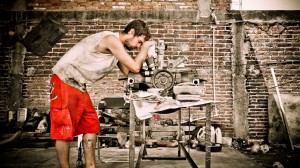
Now that we have those invaluable manuals I have been able to confront mechanics and machine shops when work is done ‘out of specification’. Do you know what answer we hear back? “Your 5 manuals are wrong, that’s not how it should be done, even all the manuals agree with each other, this is how we do things around here!”
By no means am I arrogantly claiming to be better than the ‘professional’ mechanics that we have thus far uncounted, but I do care more!
I take satisfaction in knowing that things are done properly, pride in being able to get my own wheels rolling again, and a huge comfort in knowing that if it breaks it is my fault and not the fault of someone I will never see again.
Why have you had so many problems with your Bus?
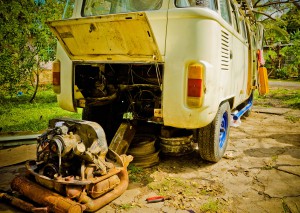
An ongoing debate with the Bus enthusiasts. It is a combination of factors but basically, it all comes down to overheating.
Between Chile and Mexico, we had the same tired Brazilian crankcase and oil pressure was never very good – tops 20psi, even after it had been reworked a couple of times. Our VW engine might be air-cooled but it is the oil that does a lot of the work of keeping things moving freely so this was a major factor. A head temperature sensor would have been very useful here, but try as we might, we haven’t been able to find one in Latin America.
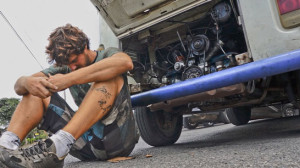
We also have to put our hands up and admit that we have asked too much from Co’Pito – although he chugged on gloriously over the Andes several times – he probably would have appreciated it if there hadn’t been 2 large boxes on the roof or 7 people and their luggage inside.
These days we don’t take passengers if we are in mountainous terrain and try to keep the weight down to a minimum at all times.
One thing with the engine is that it requires a lot of maintenance and a good ear for diagnostics. If a cable comes loose, or something goes wrong (which it does often) then we need to fix it ASAP – continuing to drive long distances with an engine that is only running on 3 cylinders is bad for any car, it is much worse for a small VW engine that doesn’t have the displacement to power through the issue…the result an overworked, overheating engine and an expensive rebuild.
Many people think that all our mechanical problems are all engine-related, they are not. Bearings, window winders, brakes, torsion bars, CV joints, shock absorbers, electrical issues, door, and locks, you name it we’ve fixed it. Co’Pito continues to provide problems on an almost daily basis. If it’s not one thing it’s another. Part of the issue here is because the parts are old, partly it is because we just can’t find quality spares to install, and partly it’s because we live in our Bus 24/7, 365 days a year, it gets a lot of use.
How do you get/make electricity?
We have a very detailed article showing our full electrical system and how you can build one too.
What Van Gear / Tech do you recommend?
We get this question a lot so we made some posts about the recommended van gear and tech that we use and our van dwelling amigos use. We try to provide a variety of options for all builds and budgets. You can find that on the Van Life Page (scroll down and hit the Van Gear & Build button) or check out our Amazon Recommended Gear Store
Why are you filming and not blogging?
Blogging would certainly be easier, and it’s possible to make money through written content so that would be great too. However, we believe that you guys will feel more like you are adventuring with us if we capture everything in HD video, so that is what we are sticking to.
Obviously, huge chunks of the adventure happen when the cameras are not rolling and that is why we are sharing the written story too, so you can share everything.
Those of you who are following us across Instagram and Facebook will have noticed that our current location is different from where we appear to be on YouTUBE. That is because it just takes too long to make the episodes like we do to be able to keep up with releasing them in real-time. We are now several months behind on YouTUBE, we do work full time on sharing this adventure but it is more important to us that we film (and live) everything rather than sit down and work editing. You wouldn’t want the last half of the journey to be just footage of us editing in the Bus now, would you? All the content will come to you, we promise you that you will see everything from this adventure on YouTUBE
Why are your early videos unavailable on YouTUBE / How can I watch them?
Sorry about that. Due to the music used in our early videos, they are not available in some countries when you watch them on a mobile device like a smartphone or tablet. The good news is that you should still be able to binge-watch the Hasta Alaska series on a computer.
If you really must watch them on a smartphone you can check out our obsolete Vimeo channel for the early episodes (all apart from the first one).
Sorry for the inconvenience, it is due to YouTube licensing and out of our control.
What advice do you have for crossing the Darien Gap

There are 3 options for getting your vehicle from Panama to Colombia or vice versa:
Getting your wheels across
- OPTION 1: Shipping container (most secure, most expensive.) Your best bet is 40ft container. Fill it with 2 vehicles, you can find people looking for container shares on http://www.drivetheamericas.com/forums. Then find 2 motorcycles to fill the extra space to bring the overall cost down. You can find bikers on http://www.horizonsunlimited.com/
- OPTION 2: Roll On Roll Off (RORO) (least secure, least expensive.) This is where you hand your keys over to someone wearing a hi-vis jacket, cross your fingers and haul ass to the other side for collection. We went with this option it cost us $660 USD for Co’Pito when we had the 2 big boxes on the roof. This price included all fees at both ends. We went with this company W&W but their bad logistics caused me to have to pay for port storage for 2 weeks and things were stolen from our Bus so we can’t recommend them.
! IMPORTANT ! There is no regulation of the dockworkers and they will steal anything that is not tied down. If you are able to seal off your “house compartment” from the driving compartment you should; consider boarding it up temporarily.
- OPTION 3: Drive it!
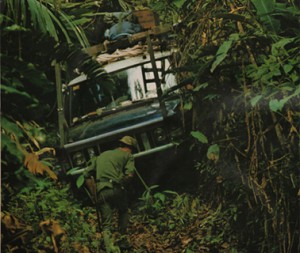
.
There might be no roads but the Darien jungle is a HUGE opportunity to supersize your adventure – why not make the most of it!
- OPTION 4: Ferry. Remember how I said there were 3 options, well there are. Option 4 is a phantom. There are continuous rumors of a ferry boat about to start the service…they have even accepted some bookings. Last we checked this new boat was still in dry dock in Greece! Needless to say, the unlucky few who booked their tickets did not get a refund. Hopefully, for everyone’s sake, the service will appear at some point, but be sure to double-check that when it does, that it really is here: http://www.vesselfinder.com/
EDIT: We just heard that this ferry service is now operational, which should make things quicker and easier for you guys, rumors of $650ish per car but we can’t confirm. Proceed with caution.
If you aren’t opting for option 3 (really, you’re not?) you will need to meet your wheels on the other side; again there are 3 options:
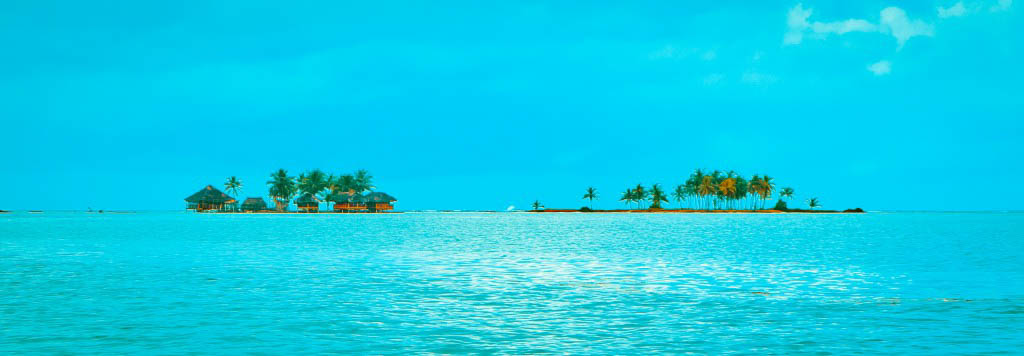
Getting yourself across the Gap
- OPTION 1: Sail. This is the most common option for travelers in need of a little luxury. There are various outfits sailing between Panama and Colombia, it will set you back something in the region of $450 – $1000+ for the 5-day trip. The good news is that everything is included, they take pretty good care of you and you get to stop at some absolutely stunning deserted islands in the San Blas. The bad news is that the sea can get pretty rough and you are stuck on the water for at least 3 days normally.
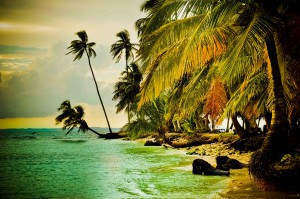
One of many magical islands Thedariengapster is a speedboat alternative that is slightly cheaper / quicker but still visits the San Blas islands. At the time of writing the cost was around $350, but demand is driving this up fast.
- OPTION 2: Fly. Flights between Panama City and Cartagena or Barranquilla on the Colombia side are around $150 – $450. If you are a larger group or family, perhaps this is your only affordable option. Remember that you have to pay storage fees for each day that you don’t remove your vehicle once it arrives, so flying is also a good option if you are in a hurry. It would be a real shame to miss out on experiencing the San Blas region so once you have your car/bike/reindeer, consider taking a boat to an island community from the Panama side, it’s MUCH cheaper that way.
- OPTION 3: Embrace the Darien! Yes it is THE major route for cocaine smuggling on the planet, yes the jungle is full of guerillas with guns bigger than Rambo, and no, it’s not a heavily traveled route. However you will see other people passing this way, you won’t get stuck in the middle of nowhere with no accommodation or food and you will have an amazing adventure, so naturally, this is the route we recommend, it cost us $190, Cartagena to Colon, me and the dog and we will never forget it!
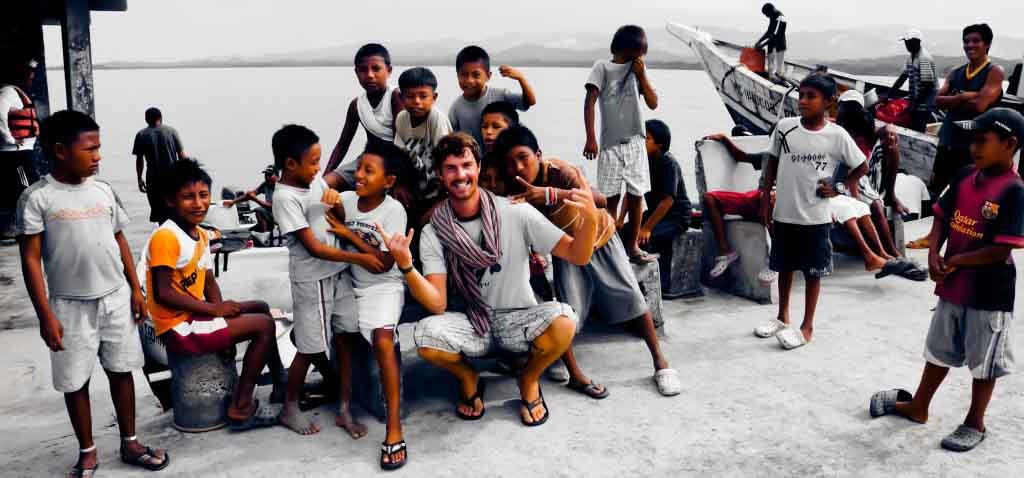
Your main travel route is. Cartagena, Colombia (where the car shipping port is) – Turbo(start/end of the road), Capurganá (Colombia Stamp In/Out here), Puerto Obaldia, Panama (Stamp In/Out here), Carti (start/end of the road), Panama City, then Colon – if you are unlucky enough to have to start/end your shipping process here, be careful – it’s a dodgy little ghetto town. If you want specific details on how to complete this journey overland by hiking and hopping around on speedboats, then check out this link: http://wikitravel.org/en/Capurgan%C3%A1
*Keep in mind it is not a good idea to pay for the travel before you arrive because you may well be left on a random island and be told to pay again from there. Also if you intend to use Puerto Obaldia airport for whatever reason you need to book ahead of time. This is a very popular back-door route for Cubans heading to the USA and flights are often booked up at this tiny jungle airstrip.
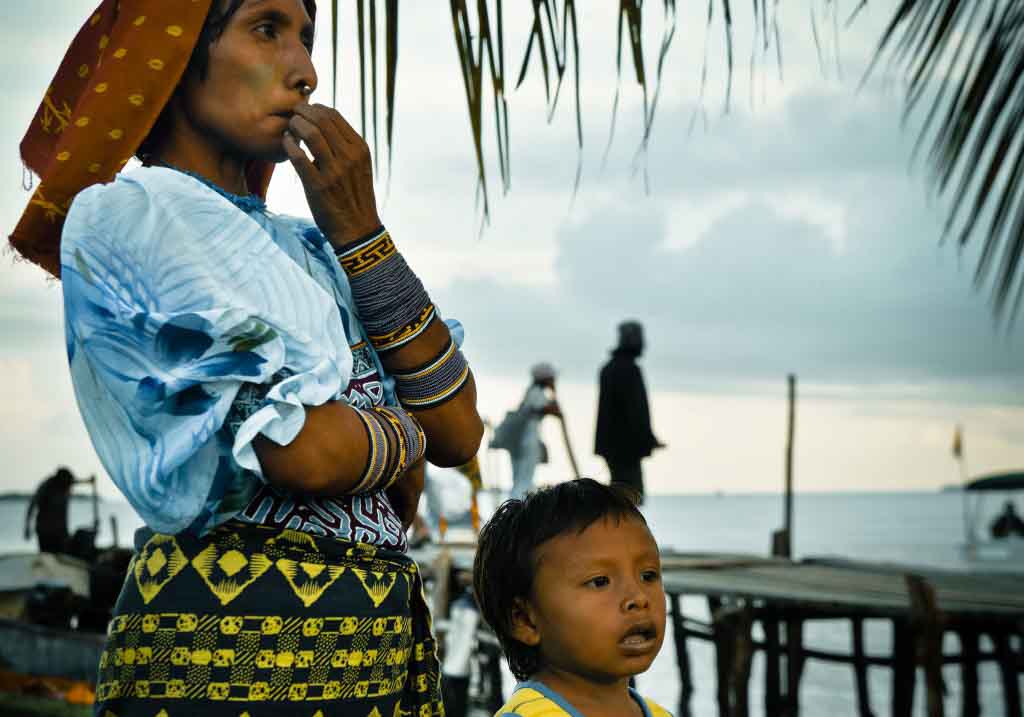
For more of the story from our Darien adventure, click here.
Do you need insurance?
Oh, so you really are planning your own trip?! That’s awesome!
Travel insurance is always a good idea to cover your valuable items and your health in case of disaster. Usually, insurance companies require proof of your outbound ticket (flight) when you make a claim so that can be difficult in the case of Overlanding. Check with your insurer before you sign a policy. If you’ve already left on your travels and want to pick up a policy your options are significantly fewer. You have to shop around, but I know that World Nomads can cover you if you are already traveling. They also allow you to renew or extend your policy whilst you are traveling which is very useful and not all travel insurance companies offer this. We recommend World Nomads as they’ve saved our butts a few times. Hey, stuff happens.
Perhaps you are also interested in vehicle insurance if you are traveling with your own wheels?
We’ve heard of policies from your home country that will cover trips like this, but that can be really difficult to find a company to cover all of your locations…and what if you change your route? Getting a policy at home is a pricey option but it might give of peace of mind if that is important to you. It may be your only option for getting a full coverage policy.
We opted for getting insurance in the countries where it was compulsory and not when it wasn’t. Any country where that is required usually has an insurance office at the border which just adds one step to your crossing procedure. Typically we paid between $8-$50 USD for 1-month insurance. When there isn’t an office available there will be one in the first town that you come to when you cross over. It is acceptable to pick up insurance at the first town, don’t let any sneaky policemen bribe you for not having insurance! Stick to your guns!
The only countries that we passed through on the Pan-American Highway where insurance was required but not checked at the border were the USA and Canada.
Thinking of heading over to Europe or around the world? Policies do exist in your home country to cover extended trips. The coverage gets more complicated once you leave the European Union and that is where you might need to source local policies, which can get pricey. The insurance offered is usually 3rd party liability insurance, which doesn’t help you with your own rig obviously, but is likely a legal requirement in many places.
If you happen to be traveling to Europe and beyond with an American-plated vehicle you are out of luck. The options became very limited in 2019 with most companies pulling out of the game, we don’t know why. There is a German company called Tour Insure who we use, they are pricey.
Sorry, we can’t help more but the situation is very different for each traveler depending on where your vehicle is registered.
Need Some Inspiration?
3 Years in One Awesome Highlights Video
